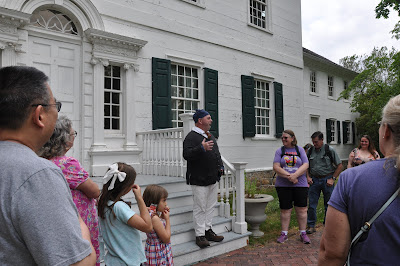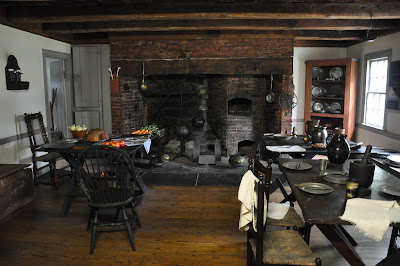After we finished our visit at the Wallace House & Old Dutch Parsonage State Historic Sites yesterday, we stopped by the Jockey Hollow area of Morristown National Historical Park on the way to our hotel in Parsippany, NJ.
We arrived about 5:45PM, long after the visitor center closing time of 4:00PM. But since the grounds were open from 8:00AM – 8:00PM, we still had plenty of time to check out the outdoor portions of the park. And we were back again first thing this morning to finish up what we missed, all before the visitor center opened at 10:00AM. How's that for maximum travel efficiency?! 😉
So, what's the significance of Morristown?
Following the 1778-79 Middlebrook Cantonment near Somerville (see the previous post), the Morristown Encampment was strategically located with the Watchung Mountains sitting between the Continental Army and the British forces in New York. Thousands of acres of trees were felled to construct over 1,000 log huts, which were built in precise rows in order to house more than 10,000 soldiers here from December 1779 to June 1780.
That winter was one of the harshest ever recorded. The temperatures rarely made it above freezing, which covered New York Harbor with ice so thick that the British could march across it from Manhattan to Staten Island. There were at least 20 snowstorms, some of which dropped more than 4 feet of snow with drifts of over 6 feet. As a result, supply lines were difficult to maintain, so the soldiers would go days without food and adequate clothing. But despite the conditions, there were fewer deaths at Morristown (~100) than in 1777-78 at Valley Forge (~2000, mostly from disease). The Continental Army emerged from that difficult winter at Morristown with the perseverance and determination they would need to face the challenges ahead.
Yesterday afternoon we drove the tour road around Jockey Hollow, stopping at the Pennsylvania Line encampment site to hike up to the replicas of the soldier huts.
 |
| Officer hut duplex |
This morning we grabbed some food from Baldwin Bagels (breakfast sandwich for R, bagel with a schmear for me, a chicken caesar wrap for lunch in the car, and muffins for breakfast tomorrow) and then headed over to Fort Nonsense.
After the victories at Trenton and Princeton (aka "Ten Crucial Days"), Washington and the army arrived in Morristown on January 6, 1777 to establish their winter camp. However, unlike what they would do three years later at Jockey Hollow, the officers and men took quarters in private homes, barns, churches, and other structures throughout town and the surrounding area. In order to secure Morristown as a supply base, Washington ordered the construction of a redoubt on a hill overlooking the town before they left camp in the spring.
 |
| The stones outline the inside walls of the fort |
With 45 minutes on our hands until the Jockey Hollow Visitor Center opened, we drove over to the Cross Estate. While the estate itself is unrelated to the American Revolution, the National Park Service acquired the property in 1975 to protect the adjacent New Jersey Brigade encampment area and connect it to the Jockey Hollow section of the park. We didn't have enough time to hike in to the encampment site, but walked through the lovely gardens instead.
 |
| Water tower |
From here it was only a short drive back to the visitor center, but since it was still about 15 minutes to opening, we decided to check out the Wick House. Henry Wick built his home around 1750, and his 1400-acre farm and the trees on his property were used for the 1779-80 encampment.
 |
| Washington did *not* sleep here, but Major General Arthur St. Clair did |
By now, it was just after 10:00AM, so we headed back to the visitor center so that I could get my passport stamps. This mural illustrating the location of some of the various brigades really helped us to understand the scale of the encampment.
The two lines of huts in the upper left corner are the Pennsylvania Line encampment, where the soldier hut replicas are located now. The Wick House is on the left side, and the visitor center would be just below the trees in the bottom left corner.
Then we zipped up to the Washington's Headquarters Museum to secure our first-come, first-serve tickets for the Ford Mansion tour. Thankfully, spots were still available for the 11:00AM tour, otherwise we might not have had time to wait for the next one.
 |
| Our tour was led by the park historian/ranger in period costume |
The home of Theodosia Ford, widow of a local militia colonel, was used by General Washington as his headquarters during the 1779-80 encampment. His wife Martha also stayed here that winter, as well as his senior staff. Yep, Al-ex-an-der Ham-il-ton (🙋🏻♀️ if you just sang his name in your head) was here, too. In fact, Alexander began his courtship of Elizabeth (♪ E-li-za!🎝) Schuyler while in Morristown.
 |
| Camp beds for the aides-de-camp |
 |
| The Washingtons likely stayed in one of the upstairs bedrooms. The table on the right is original to the house. |
After the tour, we quickly went through the exhibits in the museum. If we had taken the time to read every sign and placard, we could have spent several hours here. But that's not how we roll, so I just ended up taking pictures of almost everything to digest more thoroughly later.
Then we hopped back in the car to move on to our next stop: Thomas Edison National Historical Park. More on the rest of our day here.
 |
| 50 miles |









No comments:
Post a Comment